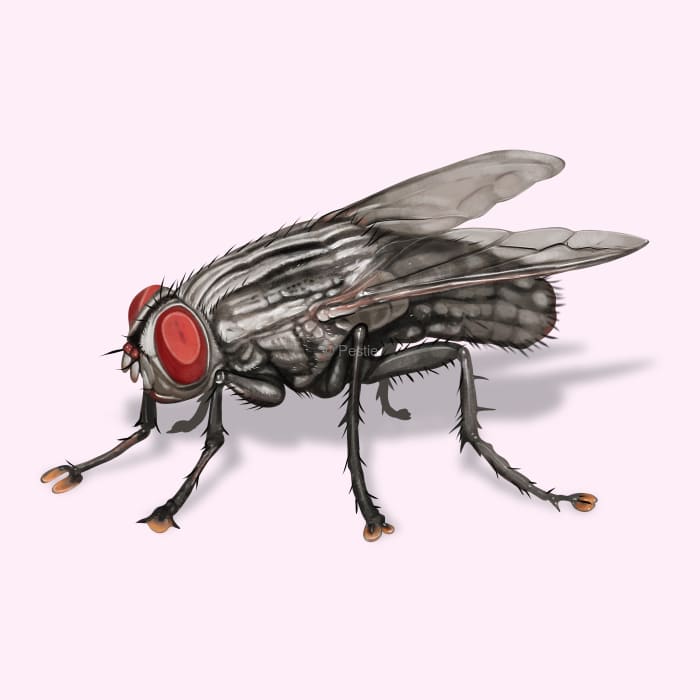How to identify and get rid of flesh flies

One man's trash is another fly's banquet
We all know flies buzzing around our food and home is annoying, but have you ever stopped to think about where those 6 feet have been stepping recently? Maybe you shouldn't think about it after all, especially if you see flesh flies in and around your home.
Flesh flies are notorious for being the first at the scene of a dead animal or marching around a pile of feces. While they are great at decomposing all the nasty stuff we don't want to mess with or smell, we still don't want them hanging around our homes, food, or family.
So, if you see flesh flies in large numbers near your home, there's a good chance a dead animal is nearby, too!
How to identify flesh flies
Flesh flies are best identified by their black and gray stripes that run down their back. They also have checkered black and grey abdomens. They are larger than common houseflies, which also helps in their identification.
Signs of an infestation include a noticeable increase in fly activity, particularly around waste disposal areas or decaying organic matter. The presence of numerous flies in these areas often indicates a breeding site nearby, which can indicate a carcass of some sort.
What other flies look like a flesh fly?
Flesh flies are frequently confused with houseflies and blowflies. Unlike their smaller housefly cousins, flesh flies feature noticeable stripes and patterns. Blowflies, on the other hand, are known for their metallic blue or green coloration.
Where do flesh flies live?
Flesh flies are adaptable and can be found throughout the United States, thriving in a variety of environments, from urban areas to rural settings. These flies are attracted to garbage, compost piles, pet waste outdoors, decaying organic matter, and exposed meats indoors. Anything smelly, rotting, and disgusting is a haven for these flies. They are often found in kitchens, waste disposal areas, and near pet areas.
How to get rid of flesh flies
One of the biggest ways to prevent flesh flies from disturbing your indoor and outdoor activities is sanitation. Keep your home and surrounding property clean of pet droppings, decomposing organic matter, or food waste. It's also a good idea to keep trash cans and dumpsters as far away from the home as possible.
To keep flies out of your home, repair screen doors or windows, seal gaps, and keep trash cleaned and removed from the home.
If you see lots of flies in your home, you might have a dead animal in a wall, attic, basement, or crawlspace. Indoor fly traps can control flies in the house, along with a trusty fly swatter.
For the best pest protection, check out Pestie's DIY pro-grade subscription, which offers a custom solution that takes only minutes to apply around your home. You'll sleep better knowing your home is protected from six-legged invaders.
Treat flesh flies with Pestie
If you're still having trouble keeping flesh flies away, the best option is to use a pro-grade, effective pest control solution like Pestie.
Pestie is a do-it-yourself pest control solution that's specially designed to keep flesh flies and other pests away from your home.
With Pestie, you can rest easy knowing that your living space is protected and free of creepy crawlies. And the best part? It's designed for people, pets, and the planet, so you can say goodbye to harsh chemicals and hello to peace of mind!
- Save hundreds compared to traditional annual pest plans
- People, pet, and planet-friendly
- Pro-grade customized formulas
Quick facts
How dangerous are Flesh Flies?
Medium danger risk
While they are not directly harmful, they can act as vectors for bacteria and pathogens, posing indirect health risks. Since they are crawling around in unsanitary conditions, if they land on your food, it's possible that they can contribute to food poisoning, diarrhea, and dysentery.
- Scientific name
Sarcophagidae
- Colors
Black and grey, striped and checkered
- Life span
8-10 days to go from egg to adult, and the adults will live for around 2-3 weeks
- Diet
Animal carcasses, garbage, rotten organic matter
Flesh flies can reproduce so fast because the females don't lay eggs but instead give birth to maggots or eggs that quickly hatch after being laid. That way, the maggots can take advantage of any fresh carcass that has recently died.








